| dc.contributor.author | ROWAN, MICHAEL | en |
| dc.date.accessioned | 2011-11-24T10:49:35Z | |
| dc.date.available | 2011-11-24T10:49:35Z | |
| dc.date.issued | 2008 | en |
| dc.date.submitted | 2008 | en |
| dc.identifier.citation | Shankar, GM, Li, S, Mehta, TH, Garcia-Munoz, A, Shepardson, NE, Smith, I, Brett, FM, Farrell, MA, Rowan, MJ, Lemere, CA, Regan, CM, Walsh, DM, Sabatini, BL, Selkoe, DJ, Amyloid-β protein dimers isolated directly from Alzheimer's brains impair synaptic plasticity and memory., Nature Medicine, 14, 8, 2008, 837-842 | en |
| dc.identifier.issn | 1078-8956 | en |
| dc.identifier.other | Y | en |
| dc.identifier.uri | http://hdl.handle.net/2262/60917 | |
| dc.description | PUBLISHED | en |
| dc.description.abstract | Alzheimer?s disease (AD) constitutes a rising threat to public health. Despite extensive research in cellular and animal models, identifying the pathogenic agent present in the human brain and showing that it confers key features of AD have not been achieved. We extracted soluble amyloid ??protein (A?) oligomers directly from the cerebral cortex of typical AD subjects. The oligomers potently inhibited long term potentiation (LTP), enhanced long term depression (LTD), and reduced dendritic spine density in normal rodent hippocampus. Soluble A? from AD brain also disrupted the memory of a learned behavior in normal rats. These various effects were specifically attributable to A? dimers. Mechanistically, metabotropic glutamate receptors (mGluR) were required for LTD enhancement and NMDA receptors (NMDAR) for spine loss. Co-administering antibodies to the A? N-terminus prevented the LTP and LTD deficits, whereas antibodies to the mid-region or C-terminus were less effective. Insoluble amyloid plaque cores from AD cortex did not impair LTP unless they were first solubilized to release A? dimers, suggesting that plaque cores are largely inactive but sequester A? dimers that are synaptotoxic. We conclude that soluble A? oligomers extracted from AD brains potently impair synapse structure and function and that dimers are the smallest synaptotoxic species. | en |
| dc.description.sponsorship | Mass spectrometry was performed by the Taplin Biological Mass Spectrometry Facility (S. Gygi). We thank X. Sun and W. Qiu for performing ELISA. We thank members of the Selkoe laboratory for helpful comments. G.M.S. recognizes L. Gurumani for support and encouragement. This work was supported by National Institute on Aging grant AG R01 027443 (D.J.S., G.M.S., S.L., T.H.M., N.E.S.), Science Foundation Ireland grant 03/IN3/B403C (C.M.R., A.G-M.), and Wellcome Trust grant 067660 (D.M.W., I.S.). | en |
| dc.format.extent | 837-842 | en |
| dc.language.iso | en | en |
| dc.relation.ispartofseries | Nature Medicine | en |
| dc.relation.ispartofseries | 14 | en |
| dc.relation.ispartofseries | 8 | en |
| dc.rights | Y | en |
| dc.subject | Neuroscience | en |
| dc.subject | Alzheimer?s disease (AD) | en |
| dc.title | Amyloid-β protein dimers isolated directly from Alzheimer's brains impair synaptic plasticity and memory. | en |
| dc.type | Journal Article | en |
| dc.type.supercollection | scholarly_publications | en |
| dc.type.supercollection | refereed_publications | en |
| dc.identifier.peoplefinderurl | http://people.tcd.ie/mrowan | en |
| dc.identifier.rssinternalid | 59336 | en |
| dc.identifier.doi | http://dx.doi.org/10.1038/nm1782 | en |
| dc.subject.TCDTheme | Ageing | en |
| dc.subject.TCDTheme | Neuroscience | en |
| dc.identifier.rssuri | http://dx.doi.org/10.1038/nm1782 | en |
| dc.contributor.sponsor | Science Foundation Ireland (SFI) | en |
| dc.contributor.sponsorGrantNumber | 03/IN3/B403C | en |




